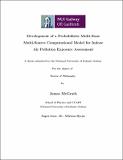| dc.description.abstract | Airborne Particulate Matter (PM) is a major environmental concern because of its known impacts on human health, and since the developed world population spends approximately 89% of its time indoors, PM in the indoor environment deserves particular attention. The use of computational models in predicting exposure to gaseous or particulate indoor air pollutants has been well documented. However, due to the existence of large uncertainties surrounding the parameterisation of exposure models, probabilistic approaches are necessary, and these type of models have had limited development to date. In this thesis, the development of an existing probabilistic model, the INDAIR model, into a state of the art model, IAPPEM, is described, and IAPPEM's ability to fully assess the distribution of particulate air pollutants in dwellings is demonstrated through analysis of the results of a wide range of simulations. Adaptations to the original code from which IAPPEM was developed include an increase in time resolution to one minute, the incorporation of 12 simultaneously operating emission sources, and up to 15 interconnecting rooms. Additionally, the model, which originally calculated airflow on a time-weighted average basis, was adapted to include a variable airflow rate, and the results of simulations demonstrate that without this feature, under-prediction of PM2.5 concentrations by up to 28% occurs. Further, a modified PM10 deposition rate, which accounts for the variability in PM2.5/PM10 ratios, was incorporated in IAPPEM, and the results of simulations show that this results in prediction of mean concentrations that are 58% higher than those calculated using the unmodified model. Simulations carried out with a one minute time-resolution compared with a fifteen minute time-resolution resulted in the estimation of peak PM concentrations that were 20% higher.
Using IAPPEM, a detailed analysis of overall PM contribution from multiple different emission sources, in a variety of different internal locations in a dwelling, has been carried out for the first time, and the effect that both emission source location and internal household configuration has on PM transfer throughout a dwelling has been quantified. IAPPEM combines a time activity model (which describes how individuals move through different zones in a dwelling) with the physical pollutant model, to create an air pollutant exposure model. The results of the simulations conducted in this study found that calculating exposure based on time averaged profiles is a poor substitute when compared with calculating exposure based on time activity profiles. In each simulated scenario, the time-averaged approach under-predicts mean exposure, in some cases by up to 75%. Additionally, the time-averaged approach fails to provide any information on peak exposure, whereas the time activity profile approach provided key information on this aspect. | en_US |


